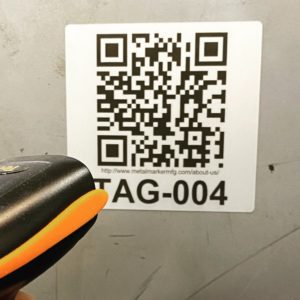Automatic Identification and Data Collection (AIDC) is a blanket term incorporating many types of technology and equipment.
Essentially, any technology which allows for identification and data capture in an automated process is considered AIDC.
It replaces or improves upon the use of manual data entry, helping to eliminate errors while simultaneously speeding up processes.
AIDC Types
Barcodes
Linear or one-dimensional barcode symbols are made of differing vertical black lines on a white background. This type of barcode is used for housing a basic set of information.
For example, products of nearly all types are outfitted with a Universal Product Code (UPC) which is then scanned to provide information about the item.
2D barcodes differ from linear codes in several ways. Instead of vertical lines, their format is a white square comprised of smaller black squares. This provides the ability to store more information in a single code.
There are varying symbol types which fall under the 2D classification. Two of the most widely adopted styles are the Data Matrix and the QR Code.
QR codes are used in nearly any type of application imaginable. From manufacturing quality control systems to adorning a business card. Data Matrix codes are used by the military for UID codes, and also used in many small electronics parts (as well as many more applications).

Barcodes are scanned using a specialized device which can read and write information to the code. This is typically a handheld scanner (like the ones you see at the supermarket). A scan provides instant information on board the device, or into a connected computer system.
Barcodes are often added to machinery or other equipment using tags, nameplates, or labels. This surprisingly simple solution turns any item into a traceable asset.
For example, every time an asset is scanned, its location can be updated in the system to provide a record.
Automated Scales and Scanners
In highly modernized shipping and receiving operations, packages are often automatically weighed and measured. Scanners and sensors can detect the dimensions as well as weight to help sort the shipments to the correct areas.
This can save a tremendous amount of time in comparison to manual measuring and weighing.
RFID
Radio Frequency Identification (RFID) is a method of sending and receiving information via close range using a transponder. An RFID device sends out a signal with a small antenna which can be picked up by specified readers nearby.
This method provides information as soon as a transmitter is within range of a reader. Unlike barcode methods, RFID does not need to be specifically scanned first to be read.
RFID is often used for location data as it outputs a signal without the need for manual scanning.
Multi-Modal Data Collection
In more complex operations, often more than one of the AIDC methods are used in conjunction. This has the ability to provide a more accurate picture of information. Multiple data points offer a better overall look at an asset or operation.
Other AIDC Technologies Include:
- Facial Recognition
- Smart Cards
- Magnetic Strips
- And More
AIDC Nameplates
The most commonly used form of AIDC is barcoding. Barcodes are a simple but powerful tool that can completely transform an organization and its processes.
Barcodes are often applied to equipment, tools, machines, and other assets using custom metal nameplates or printed labels.
These nameplates and labels are used in a wide range of industries.
Some examples include:
- Manufacturing
- Food Production
- Medical Devices and Equipment (UDI Labels)
- Shipping and Logistics
- LDAR Nameplates
- Warehousing and Inventory Management
- Many More
What Information is Included?
AIDC nameplates can include more than just a simple barcode. They are typically produced with human readable information adjacent to various code symbols.
The specific information can vary by industry or application. Some of the most commonly used elements include:
- Manufacturer Information
- Product Numbers
- Unique Identification Codes (UID)
- QR Codes
- Data Matrix
- Contact Information
- Website Links
This dual system of human readable information (HRI) alongside the automation of barcodes creates a versatile marking solution that can accommodate many roles.
Marking Processes for AIDC Nameplates
Selecting the right marking process for an AIDC nameplate can make a large difference in the success of application.
Photo Anodization
One of the most popular marking processes due to its versatility, photo anodized nameplates are often used when barcodes are a requisite.
The fully custom nature of photo anodization means it can accommodate any type of AIDC-related code symbol. This includes:
- QR Codes
- Barcodes
- Data Matrix
- UPC Codes
- And More
This process directly embeds a custom design in an anodized aluminum material, providing outstanding durability in industrial conditions. The nameplates will last upwards of 20+ years, even in an outdoor setting.
Digital Printing
Another commonly used process, digital printing also offers custom designs with the caveat of less durability. Its topical ink can include full colors, but is significantly more susceptible to wear and fading.
This process is often used for printing barcodes onto vinyl or polyester decals, as well as similar substrates.
These adhesive backed labels can sometimes fit a specific AIDC application better than a metal nameplate.
Wrap-Up
There are too many reasons to list why organizations elect to implement AIDC technologies. It effectively boils down to more accurate and faster access to information.
AIDC technology can turn two minutes of manual data entry in a log book into an instant scan. This simplification of processes not only saves time, but leads to more accurate records as well.
Eliminating the need for guesswork and reducing human error can save both time and organizational resources.
In addition, having a better level of traceability can improve overall organizational efficiency. Inventory management heavy industries such as warehousing can benefit tremendously. AIDC solutions have become nearly mandatory in these spaces.